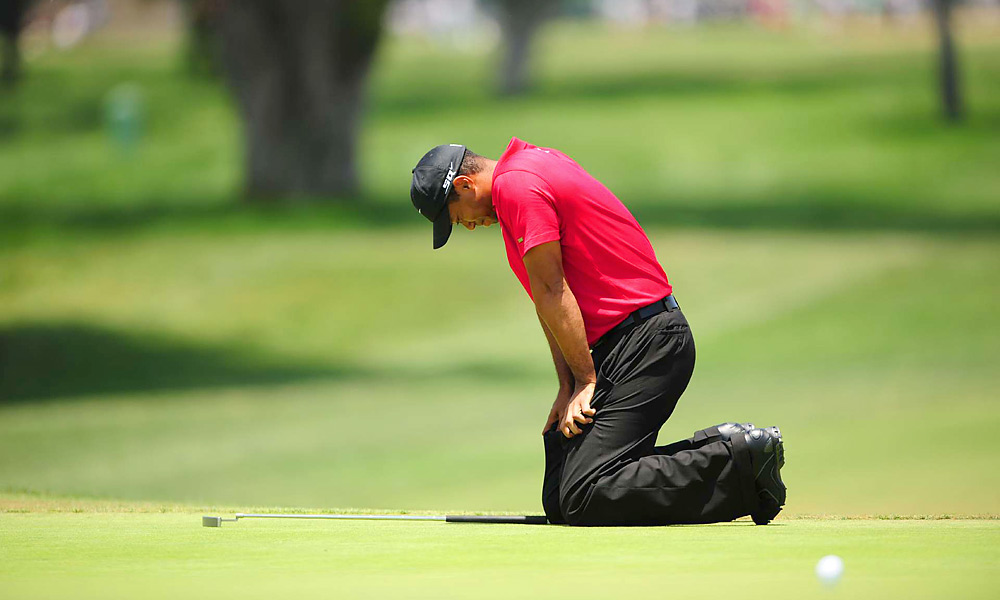You just got the call you have been waiting for all summer. Your brother-in-law’s father belongs to one of the best country clubs in the city and you have been itching to play the course since the day he married your sister. Your prayers are finally answered when, during the call, he casually mentions, “I got a tee time this afternoon and would you like to join him at his dad’s club?” Overwhelmed and excited, you rush home, put on your best golf shirt, kiss the wife goodbye and drive to the course. After checking in with the starter, you head for the range, grab a bucket of balls and anxiously, thinking you are Dustin Johnson, start trying to power them 300 yards into the fence. Somewhere along the way, you feel a slight twinge but you ignore it while beating ball after ball into the bright summer sky. The pain gets worse the more you play and the grand expectations you had at the start of the day are long gone as you struggle to finish the round. Later that night, when you cannot lift your arm or get out of your chair to let the dog out, you wonder why you hurt so bad, “After all,” you say, “all I did was hit a few golf balls.”
Welcome to a world where, as PGA Professional and Licensed Physical Therapist, Henry White, of Performance Golf & Wellness Center reports, most recreational golfers never think they will ever end up. “The golf swing, because of the twisting motion involved and the golf specific muscles needed to generate power may cause damage to your back, knees, wrists and shoulders, if done incorrectly.” White says, and others specialists agree, golfers could lessen their chance for injury by stretching and warming up before they go out to play or practice. “Golf is a sport you must train for just like any other athletic activity.
Causes and Types of Golf Injuries
There have been very few reports of golfers not named Tiger Woods seriously injured on the golf course. It is more often than not a case of your re-injuring or aggravating an old injury or over compensating because of those previous injuries. As orthopedic surgeon Dr. Lonnie Paulos suggests, most of the golf injuries he sees, especially to shoulders and knees, are the result of old injuries that have resurfaced. As you get older, muscle groups lose their flexibility and range of motion. In trying to over swing, whether practicing or playing, you strain or pull those muscles and the ligaments surrounding them. While painful, these injuries certainly are not life threatening, nor will they keep you from playing if you take care of them.
There have been a number of studies done on types and causes of golf related injuries. One of the most recent is a study of English amateur golfers where 461 adult players were asked about their injuries received while participating in golf related activities. Of the 193 golfers who answered the survey, 57% reported receiving actual or incidental injuries. Of the total group who reported injuries, 52% of the men and 32% of the women complained of back pain. The most common problem cited by the younger and better players was to the wrist, usually caused by over practice, while most hip, knee and lower body problems were associated with older players.
When asked what the main factors influencing their problems were, most respondents suggested that overuse, incorrect swings and playing conditions were most responsible for their injuries. Players with back problems indicated that not all of the causes of their injuries are from swinging a golf club, but from a failure to warm up, or from lifting their golf bag with a twisting motion. Some of those who injured their backs while playing suggested they were trying to hit the ball too hard.
What this and other studies show is that injuries can happen on the golf course, but what is also known is that most golf related injuries can be prevented with proper preparation and improved technique.
Prevention
Every expert I have talked to, from doctors to physical therapists to PGA Professionals, emphatically stated the best way to avoid hurting yourself on the golf course is to remember the golf swing puts a great deal of stress on joints and muscles that normally don’t get that kind of use. These muscles need to be improved and stimulated with exercise before you play. These experts also suggest every exercise program you undertake should include drills that Dr. David Petron, of the University of Utah’s Sports Medicine Center, calls “sport specific,” meaning you should not train for a marathon and then go tee it up on the golf course. If you are going to play golf, you should exercise those muscles you would normally use in a golf swing.
The doctors also suggest, if you encounter pain and stiffness after playing or practicing, you should contact a physical therapist who will evaluate your physical condition and set up an training and exercise program for you.
Henry White echoes much of the same opinion. A registered physical therapist and PGA certified golf professional who is one of the few practitioners in the country that combines these two specialties, indicates that when he treats golfers with injuries, those injuries are often a result of some other problem not the cause of it. In addition, he says, to assess the causes without looking at your golf swing is counterproductive. The first thing he does, when you make an appointment at his clinic, is to analyze and video tape your golf swing. He does this in a training atmosphere simulating actual conditions. If you say, the problem does not happen until you have hit the ball fifty times; then White has you hit fifty golf balls. If it happens only when you use your driver, then he has you hit your diver until the problem is revealed and can be assessed using strength and flexibility testing. White also performs a complete medical history exam to determine what past injuries and genetic problems you may have. Only when he has isolated and measured the problems will he attempt to prescribe corrective measures and treatment.
Treatment
Normally golf related injuries require no more than taking some time off to let the muscles recover, combined with over-the-counter medication. However, there are times when the injury is of sufficient pain and duration that you would want to seek medical attention.
Doctors Paulos and Petron both suggested five stages of treatment: Number one is to wrap and cover the affected area with ice. This diminishes the pain, reduces inflammation, and decreases swelling. Oftentimes this is all the injury needs. The second stage is necessary if, after 48 hours, there is still pain, but the swelling has gone down, then heat may be applied to the area improving motion and flexibility. This helps loosen the muscles so they can function better. Stage three is the use of muscle relaxants to control muscle spasms and anti-inflammatory medications, which will control the pain and reduce inflammation. The fourth treatment option, if pain persists, is an outpatient procedure performed in a doctor’s office as an alternative to surgery and involves injections of Corticosteroids into the affected area. Commonly referred to cortisone shots, they can provide temporary relief from most sports injuries. The final, and most invasive method of treatment, is surgery to treat or repair the injured area or the surrounding muscles and tendons. Usually this is necessary because of scar tissue that has accumulated over years of abuse and calcium deposits that grate or “impinge” the movement of the joint, whether they are to the back, shoulders or hips.
The last stage is critical because recovery time from surgery can last three to six months and in the case of shoulder, or back surgery, can take a full nine to twelve months for recovery. Therefore, if you require surgery, it is much better to plan it well ahead of any golf trips you have planned and preferably scheduled during the winter off-season months.
Recommendations
Golf is not a dangerous sport, and, while accidents can happen, statistics show that most injuries occurring on the golf course will be prevented by proper conditioning and utilizing proper techniques. What is dangerous is the fact that the golf swing does put a great deal of stress on the lower back if done incorrectly. When poor technique, coupled with the prevailing attitude that golf is not a physical sport and does not require training or conditioning, accidents can and do happen.
To fully enjoy the game of golf and reduce the chance of injuries spoiling that enjoyment I recommend you do six things:
- Avoid overuse, by stopping practice or playing whenever you are tired or feel pain.
- Build strength and flexibility through conditioning exercises designed specifically for golf. Avoid sudden side movements and twisting in the golf swing.

- Improve your technique by taking lessons from your local PGA Professional.
- Download your free copy of my instruction book: The Ten Commandments of Golf, Proven Principles That Make Your Golf Game Better. This book contains detailed drills and exercises for every component of your golf swing and can be downloaded at: www.jeffgolfguy.com
- Make an appointment with a physical therapist to analyze your golf game, physical limitations, strength and flexibility.
All these suggestions should be combined with systematic practice to not only improve your golf swing, but also to exercise your golf muscles. By building strength and endurance, you can enhance your health, reduce your chance of injury, and improve your golf scores.
Moreover, who knows, if you improve your golf scores enough, the next time your brother-in-law calls with an invitation to play at his father’s club, you can inflict some really serious pain on his pocketbook.
References
Henry M. White
Physical Therapist
2936 South Highland Drive #101
Salt Lake City, Utah 84106
801-746-8997
pgwcpt@gmail.com
https://www.whitephysicaltherapy.com
David J. Petron, M.D.
Sports Medicine
University of Utah Health Care
590 South Wakara Way
Salt Lake City, Utah 84108
801-587-7100
https://www.md.com/doctor/david-petron-md
Lonnie E. Paulos, M.D.
Orthopedic surgery-sports medicine
6322 South 3000 East #140
Cottonwood Heights, Utah 84121
801-733-9924
https://www.lonniepaulosmd.com



